child seat MAZDA MODEL CX-5 2013 Owners Manual (in English)
[x] Cancel search | Manufacturer: MAZDA, Model Year: 2013, Model line: MODEL CX-5, Model: MAZDA MODEL CX-5 2013Pages: 488, PDF Size: 8.75 MB
Page 5 of 488
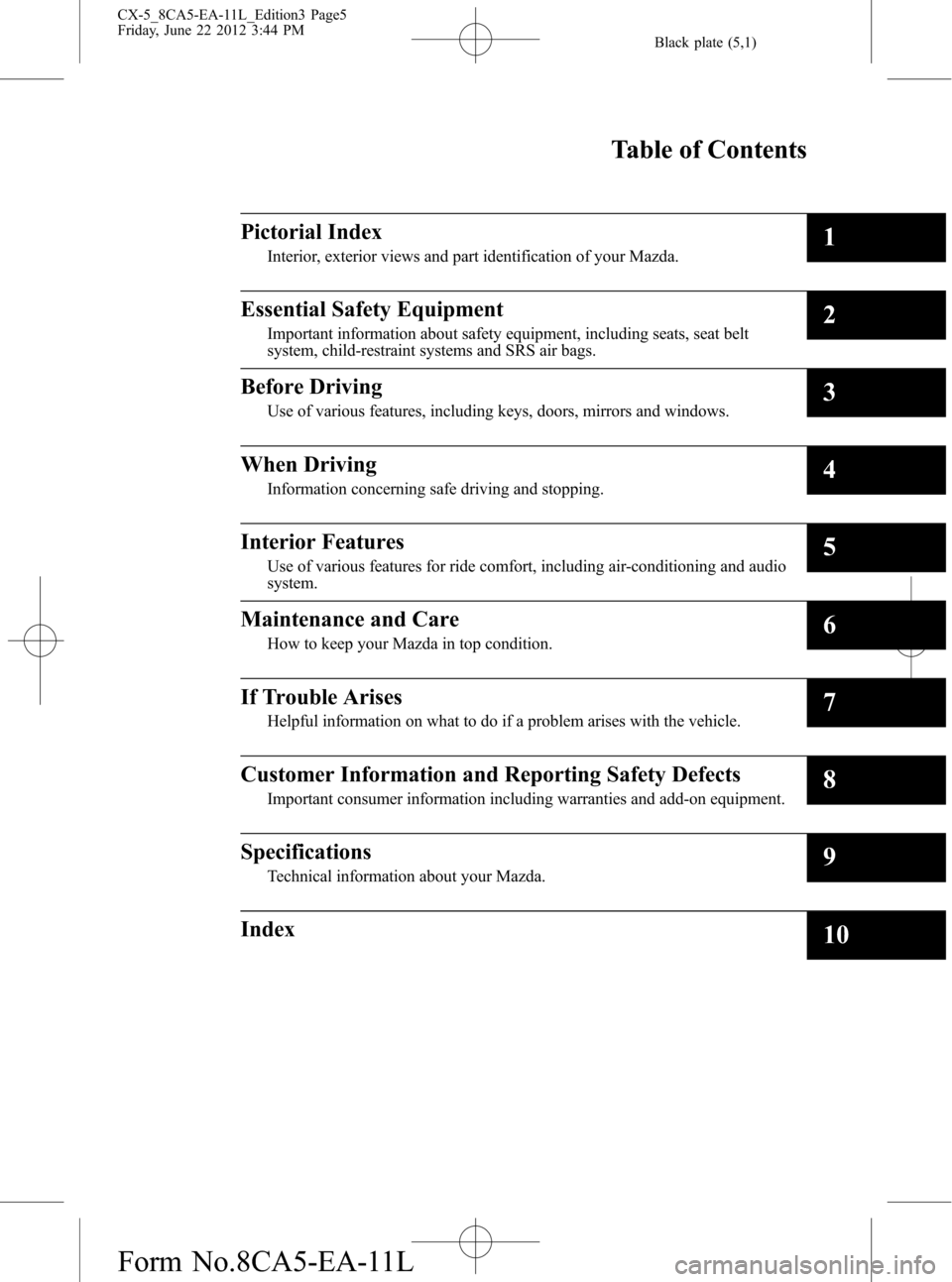
Black plate (5,1)
CX-5_8CA5-EA-11L_Edition3 Page5
Friday, June 22 2012 3:44 PM
Form No.8CA5-EA-11L
Table of Contents
Pictorial Index
Interior, exterior views and part identification of your Mazda.1
Essential Safety Equipment
Important information about safety equipment, including seats, seat belt
system, child-restraint systems and SRS air bags.2
Before Driving
Use of various features, including keys, doors, mirrors and windows.3
When Driving
Information concerning safe driving and stopping.4
Interior Features
Use of various features for ride comfort, including air-conditioning and audio
system.5
Maintenance and Care
How to keep your Mazda in top condition.6
If Trouble Arises
Helpful information on what to do if a problem arises with the vehicle.7
Customer Information and Reporting Safety Defects
Important consumer information including warranties and add-on equipment.8
Specifications
Technical information about your Mazda.9
Index10
Page 13 of 488
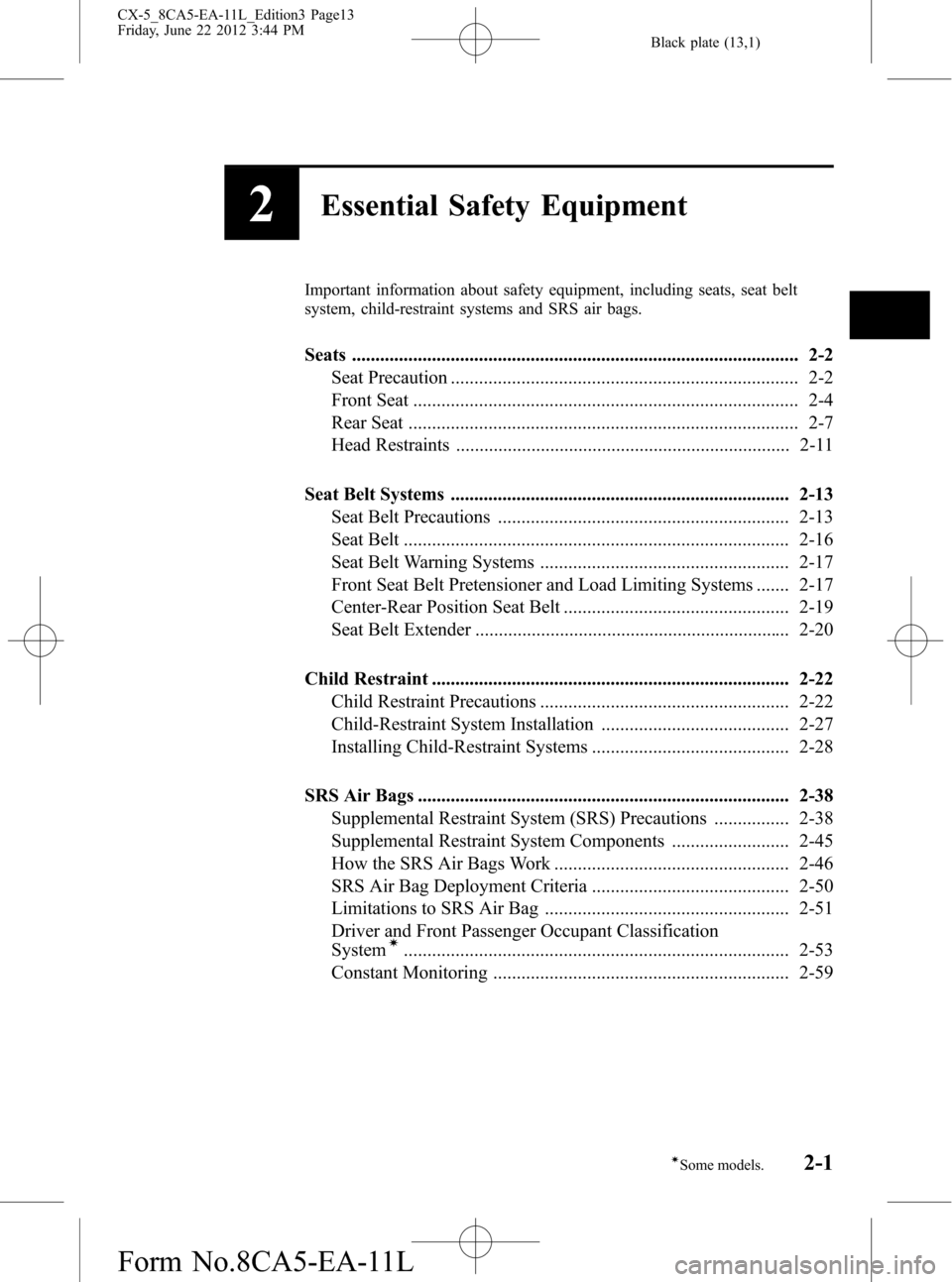
Black plate (13,1)
2Essential Safety Equipment
Important information about safety equipment, including seats, seat belt
system, child-restraint systems and SRS air bags.
Seats ............................................................................................... 2-2
Seat Precaution .......................................................................... 2-2
Front Seat .................................................................................. 2-4
Rear Seat ................................................................................... 2-7
Head Restraints ....................................................................... 2-11
Seat Belt Systems ........................................................................ 2-13
Seat Belt Precautions .............................................................. 2-13
Seat Belt .................................................................................. 2-16
Seat Belt Warning Systems ..................................................... 2-17
Front Seat Belt Pretensioner and Load Limiting Systems ....... 2-17
Center-Rear Position Seat Belt ................................................ 2-19
Seat Belt Extender ................................................................... 2-20
Child Restraint ............................................................................ 2-22
Child Restraint Precautions ..................................................... 2-22
Child-Restraint System Installation ........................................ 2-27
Installing Child-Restraint Systems .......................................... 2-28
SRS Air Bags ............................................................................... 2-38
Supplemental Restraint System (SRS) Precautions ................ 2-38
Supplemental Restraint System Components ......................... 2-45
How the SRS Air Bags Work .................................................. 2-46
SRS Air Bag Deployment Criteria .......................................... 2-50
Limitations to SRS Air Bag .................................................... 2-51
Driver and Front Passenger Occupant Classification
System
í.................................................................................. 2-53
Constant Monitoring ............................................................... 2-59
2-1íSome models.
CX-5_8CA5-EA-11L_Edition3 Page13
Friday, June 22 2012 3:44 PM
Form No.8CA5-EA-11L
Page 15 of 488
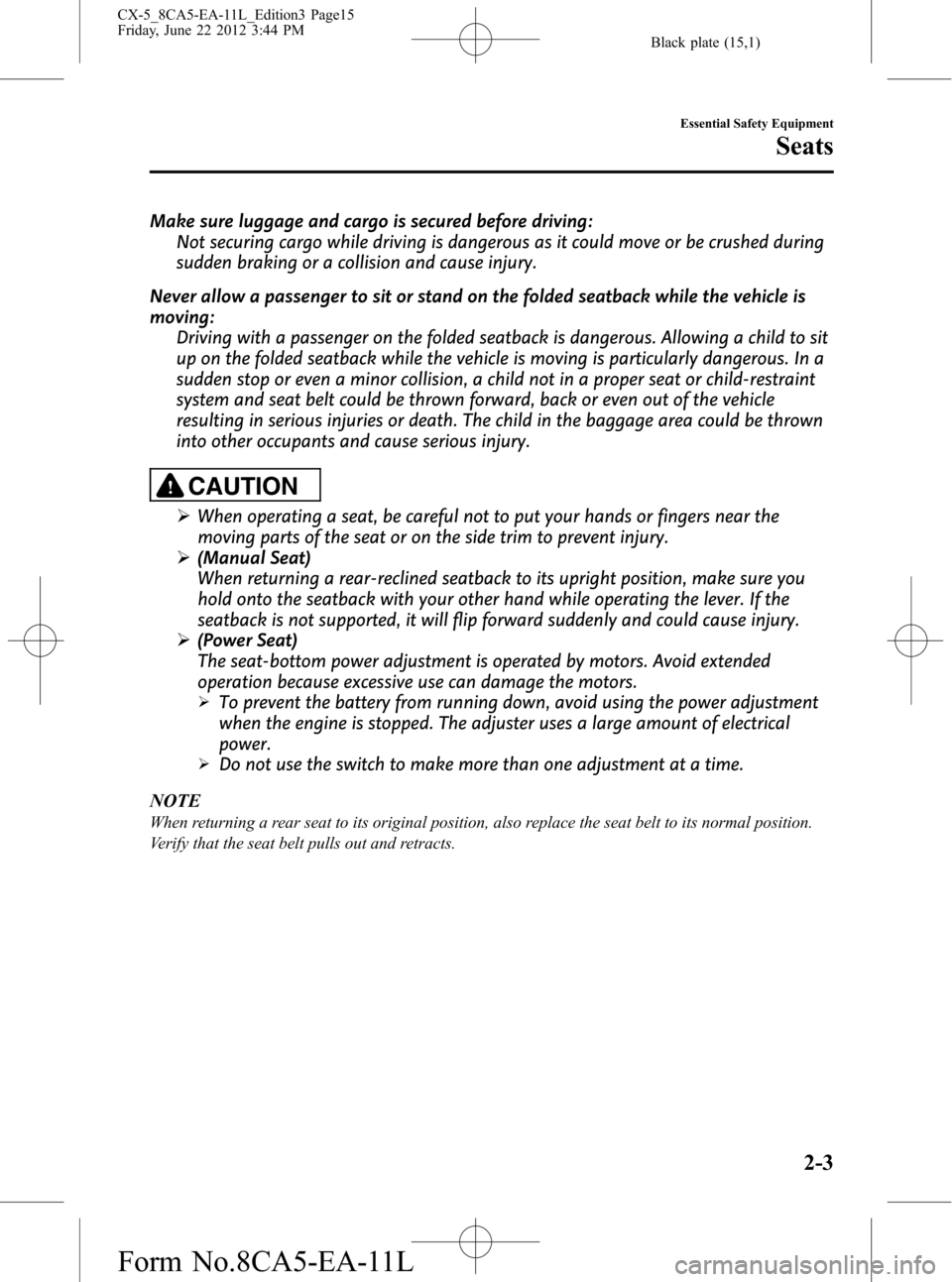
Black plate (15,1)
Make sure luggage and cargo is secured before driving:
Not securing cargo while driving is dangerous as it could move or be crushed during
sudden braking or a collision and cause injury.
Never allow a passenger to sit or stand on the folded seatback while the vehicle is
moving:
Driving with a passenger on the folded seatback is dangerous. Allowing a child to sit
up on the folded seatback while the vehicle is moving is particularly dangerous. In a
sudden stop or even a minor collision, a child not in a proper seat or child-restraint
system and seat belt could be thrown forward, back or even out of the vehicle
resulting in serious injuries or death. The child in the baggage area could be thrown
into other occupants and cause serious injury.
CAUTION
ØWhen operating a seat, be careful not to put your hands or fingers near the
moving parts of the seat or on the side trim to prevent injury.
Ø(Manual Seat)
When returning a rear-reclined seatback to its upright position, make sure you
hold onto the seatback with your other hand while operating the lever. If the
seatback is not supported, it will flip forward suddenly and could cause injury.
Ø(Power Seat)
The seat-bottom power adjustment is operated by motors. Avoid extended
operation because excessive use can damage the motors.
ØTo prevent the battery from running down, avoid using the power adjustment
when the engine is stopped. The adjuster uses a large amount of electrical
power.
ØDo not use the switch to make more than one adjustment at a time.
NOTE
When returning a rear seat to its original position, also replace the seat belt to its normal position.
Verify that the seat belt pulls out and retracts.
Essential Safety Equipment
Seats
2-3
CX-5_8CA5-EA-11L_Edition3 Page15
Friday, June 22 2012 3:44 PM
Form No.8CA5-EA-11L
Page 19 of 488
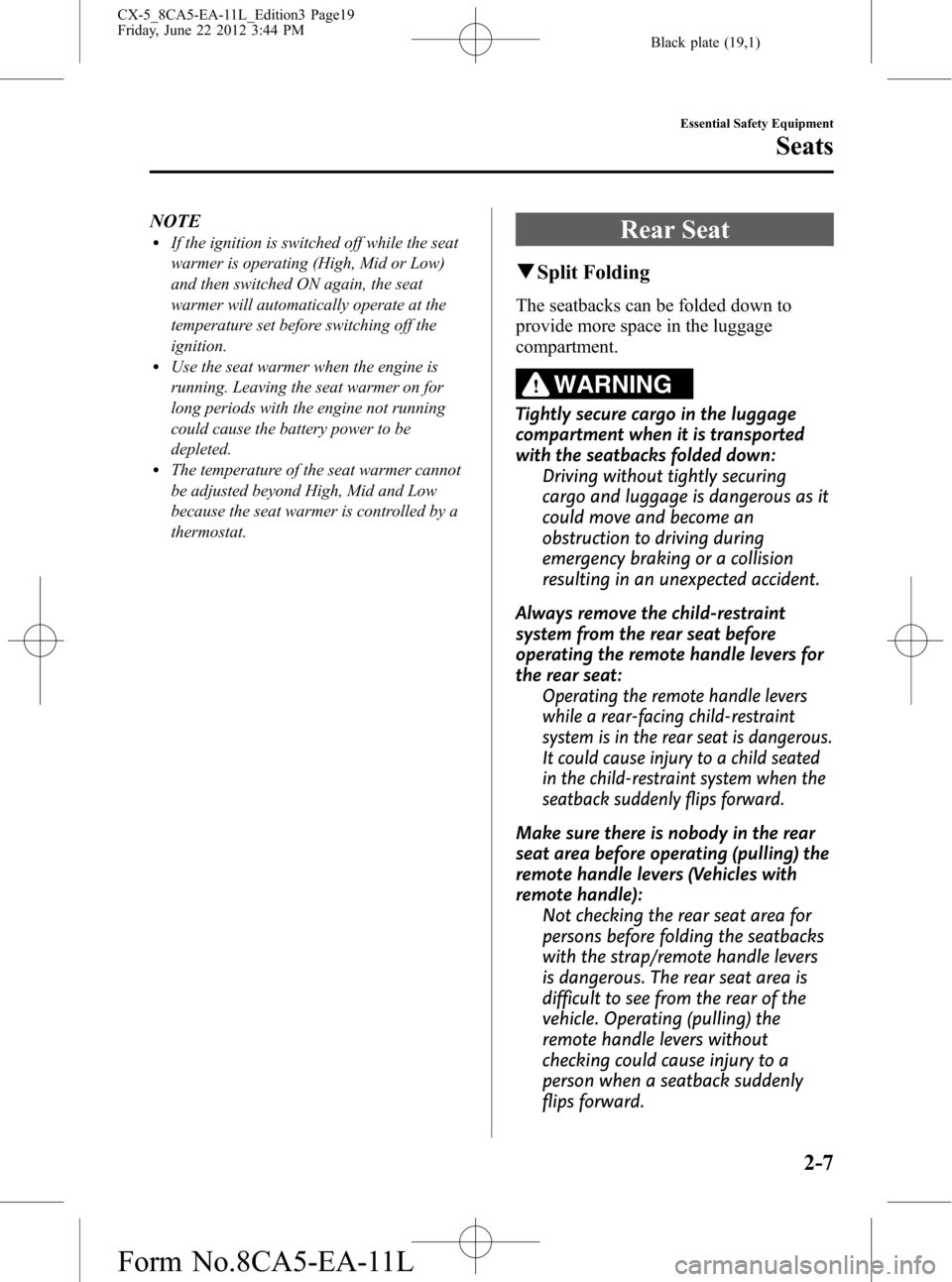
Black plate (19,1)
NOTElIf the ignition is switched off while the seat
warmer is operating (High, Mid or Low)
and then switched ON again, the seat
warmer will automatically operate at the
temperature set before switching off the
ignition.
lUse the seat warmer when the engine is
running. Leaving the seat warmer on for
long periods with the engine not running
could cause the battery power to be
depleted.
lThe temperature of the seat warmer cannot
be adjusted beyond High, Mid and Low
because the seat warmer is controlled by a
thermostat.
Rear Seat
qSplit Folding
The seatbacks can be folded down to
provide more space in the luggage
compartment.
WARNING
Tightly secure cargo in the luggage
compartment when it is transported
with the seatbacks folded down:
Driving without tightly securing
cargo and luggage is dangerous as it
could move and become an
obstruction to driving during
emergency braking or a collision
resulting in an unexpected accident.
Always remove the child-restraint
system from the rear seat before
operating the remote handle levers for
the rear seat:
Operating the remote handle levers
while a rear-facing child-restraint
system is in the rear seat is dangerous.
It could cause injury to a child seated
in the child-restraint system when the
seatback suddenly flips forward.
Make sure there is nobody in the rear
seat area before operating (pulling) the
remote handle levers (Vehicles with
remote handle):
Not checking the rear seat area for
persons before folding the seatbacks
with the strap/remote handle levers
is dangerous. The rear seat area is
difficult to see from the rear of the
vehicle. Operating (pulling) the
remote handle levers without
checking could cause injury to a
person when a seatback suddenly
flips forward.
Essential Safety Equipment
Seats
2-7
CX-5_8CA5-EA-11L_Edition3 Page19
Friday, June 22 2012 3:44 PM
Form No.8CA5-EA-11L
Page 25 of 488
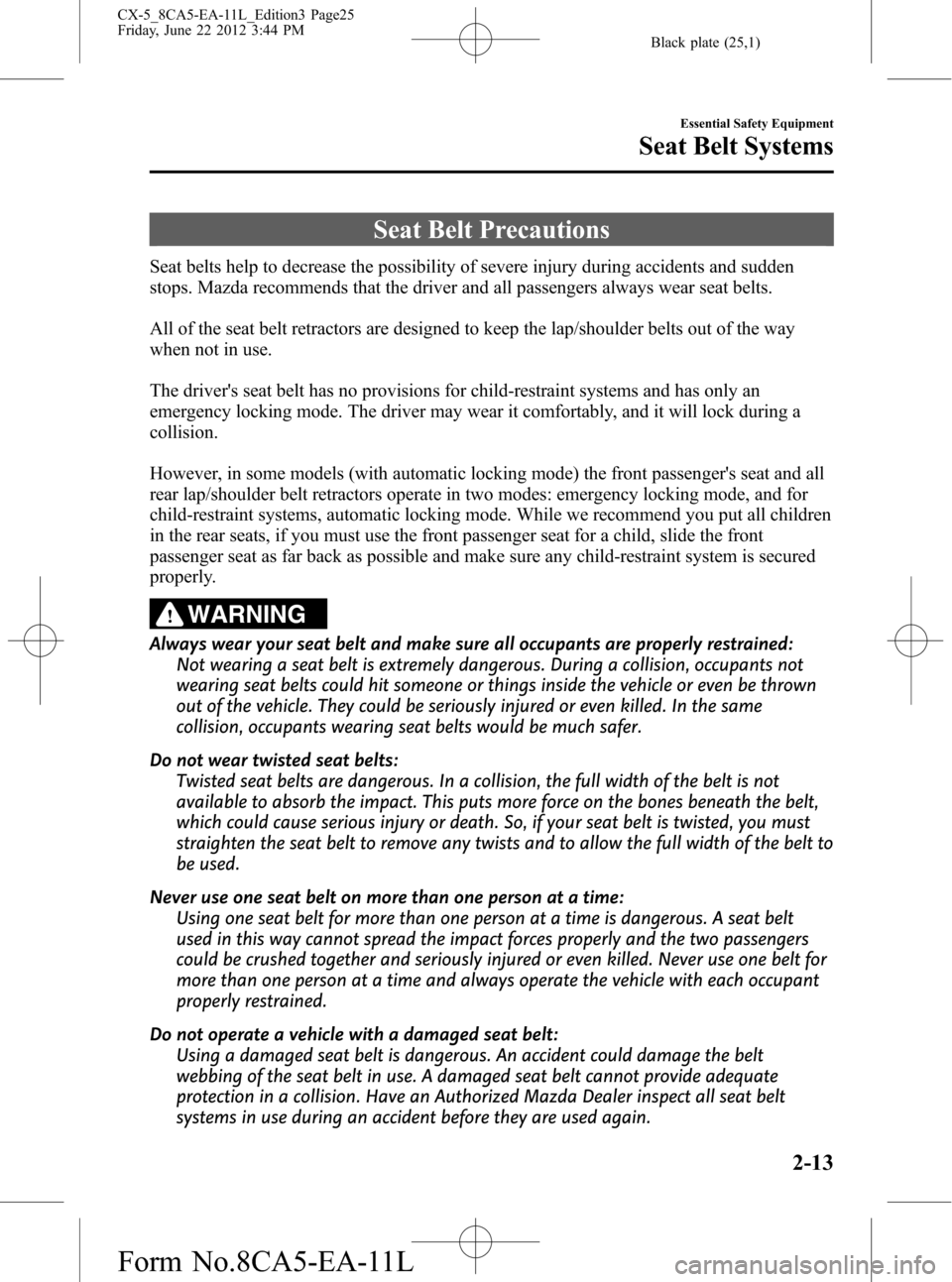
Black plate (25,1)
Seat Belt Precautions
Seat belts help to decrease the possibility of severe injury during accidents and sudden
stops. Mazda recommends that the driver and all passengers always wear seat belts.
All of the seat belt retractors are designed to keep the lap/shoulder belts out of the way
when not in use.
The driver's seat belt has no provisions for child-restraint systems and has only an
emergency locking mode. The driver may wear it comfortably, and it will lock during a
collision.
However, in some models (with automatic locking mode) the front passenger's seat and all
rear lap/shoulder belt retractors operate in two modes: emergency locking mode, and for
child-restraint systems, automatic locking mode. While we recommend you put all children
in the rear seats, if you must use the front passenger seat for a child, slide the front
passenger seat as far back as possible and make sure any child-restraint system is secured
properly.
WARNING
Always wear your seat belt and make sure all occupants are properly restrained:
Not wearing a seat belt is extremely dangerous. During a collision, occupants not
wearing seat belts could hit someone or things inside the vehicle or even be thrown
out of the vehicle. They could be seriously injured or even killed. In the same
collision, occupants wearing seat belts would be much safer.
Do not wear twisted seat belts:
Twisted seat belts are dangerous. In a collision, the full width of the belt is not
available to absorb the impact. This puts more force on the bones beneath the belt,
which could cause serious injury or death. So, if your seat belt is twisted, you must
straighten the seat belt to remove any twists and to allow the full width of the belt to
be used.
Never use one seat belt on more than one person at a time:
Using one seat belt for more than one person at a time is dangerous. A seat belt
used in this way cannot spread the impact forces properly and the two passengers
could be crushed together and seriously injured or even killed. Never use one belt for
more than one person at a time and always operate the vehicle with each occupant
properly restrained.
Do not operate a vehicle with a damaged seat belt:
Using a damaged seat belt is dangerous. An accident could damage the belt
webbing of the seat belt in use. A damaged seat belt cannot provide adequate
protection in a collision. Have an Authorized Mazda Dealer inspect all seat belt
systems in use during an accident before they are used again.
Essential Safety Equipment
Seat Belt Systems
2-13
CX-5_8CA5-EA-11L_Edition3 Page25
Friday, June 22 2012 3:44 PM
Form No.8CA5-EA-11L
Page 27 of 488
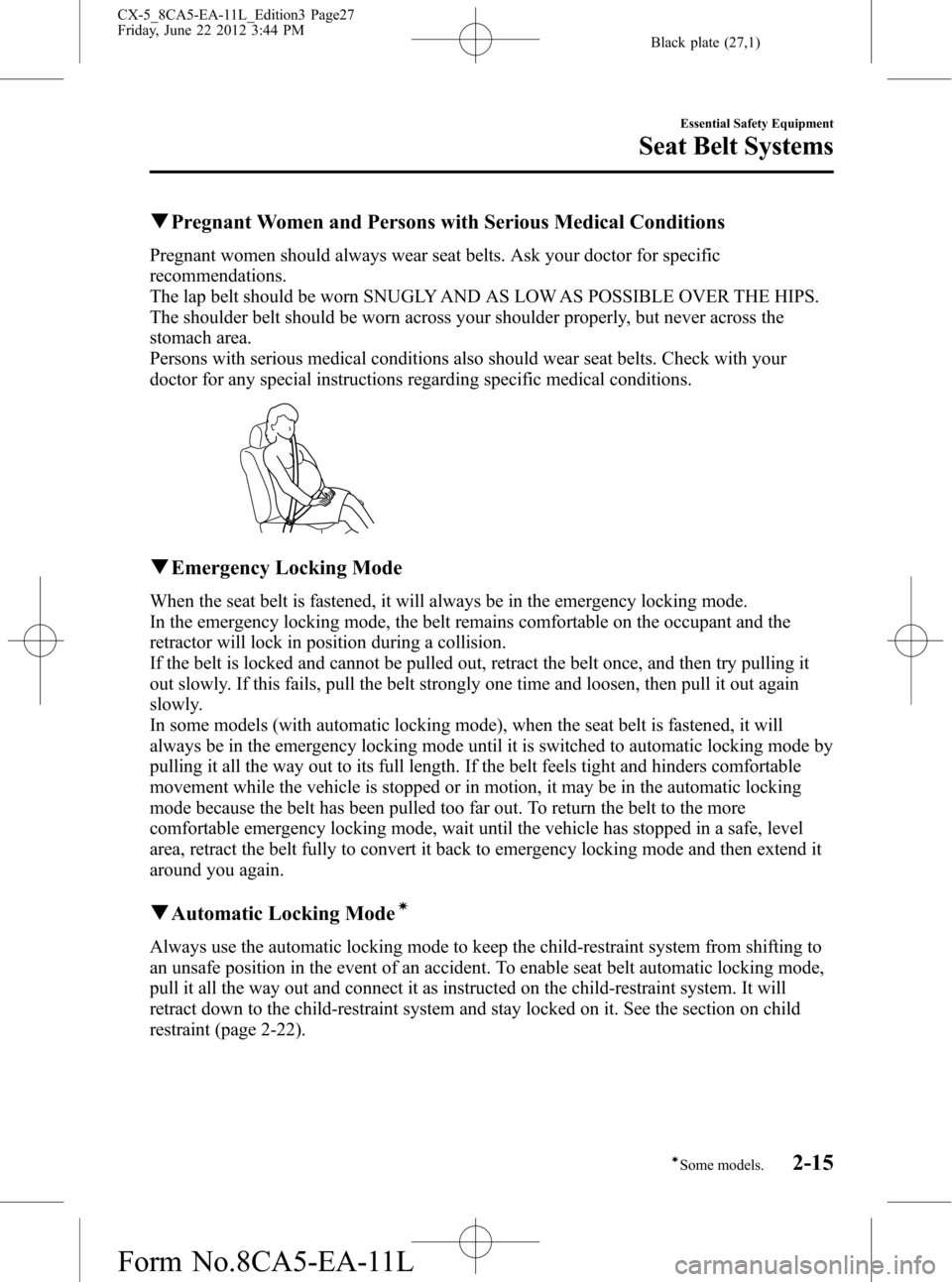
Black plate (27,1)
qPregnant Women and Persons with Serious Medical Conditions
Pregnant women should always wear seat belts. Ask your doctor for specific
recommendations.
The lap belt should be worn SNUGLY AND AS LOW AS POSSIBLE OVER THE HIPS.
The shoulder belt should be worn across your shoulder properly, but never across the
stomach area.
Persons with serious medical conditions also should wear seat belts. Check with your
doctor for any special instructions regarding specific medical conditions.
qEmergency Locking Mode
When the seat belt is fastened, it will always be in the emergency locking mode.
In the emergency locking mode, the belt remains comfortable on the occupant and the
retractor will lock in position during a collision.
If the belt is locked and cannot be pulled out, retract the belt once, and then try pulling it
out slowly. If this fails, pull the belt strongly one time and loosen, then pull it out again
slowly.
In some models (with automatic locking mode), when the seat belt is fastened, it will
always be in the emergency locking mode until it is switched to automatic locking mode by
pulling it all the way out to its full length. If the belt feels tight and hinders comfortable
movement while the vehicle is stopped or in motion, it may be in the automatic locking
mode because the belt has been pulled too far out. To return the belt to the more
comfortable emergency locking mode, wait until the vehicle has stopped in a safe, level
area, retract the belt fully to convert it back to emergency locking mode and then extend it
around you again.
qAutomatic Locking Modeí
Always use the automatic locking mode to keep the child-restraint system from shifting to
an unsafe position in the event of an accident. To enable seat belt automatic locking mode,
pull it all the way out and connect it as instructed on the child-restraint system. It will
retract down to the child-restraint system and stay locked on it. See the section on child
restraint (page 2-22).
Essential Safety Equipment
Seat Belt Systems
2-15íSome models. CX-5_8CA5-EA-11L_Edition3 Page27
Friday, June 22 2012 3:44 PM
Form No.8CA5-EA-11L
Page 33 of 488
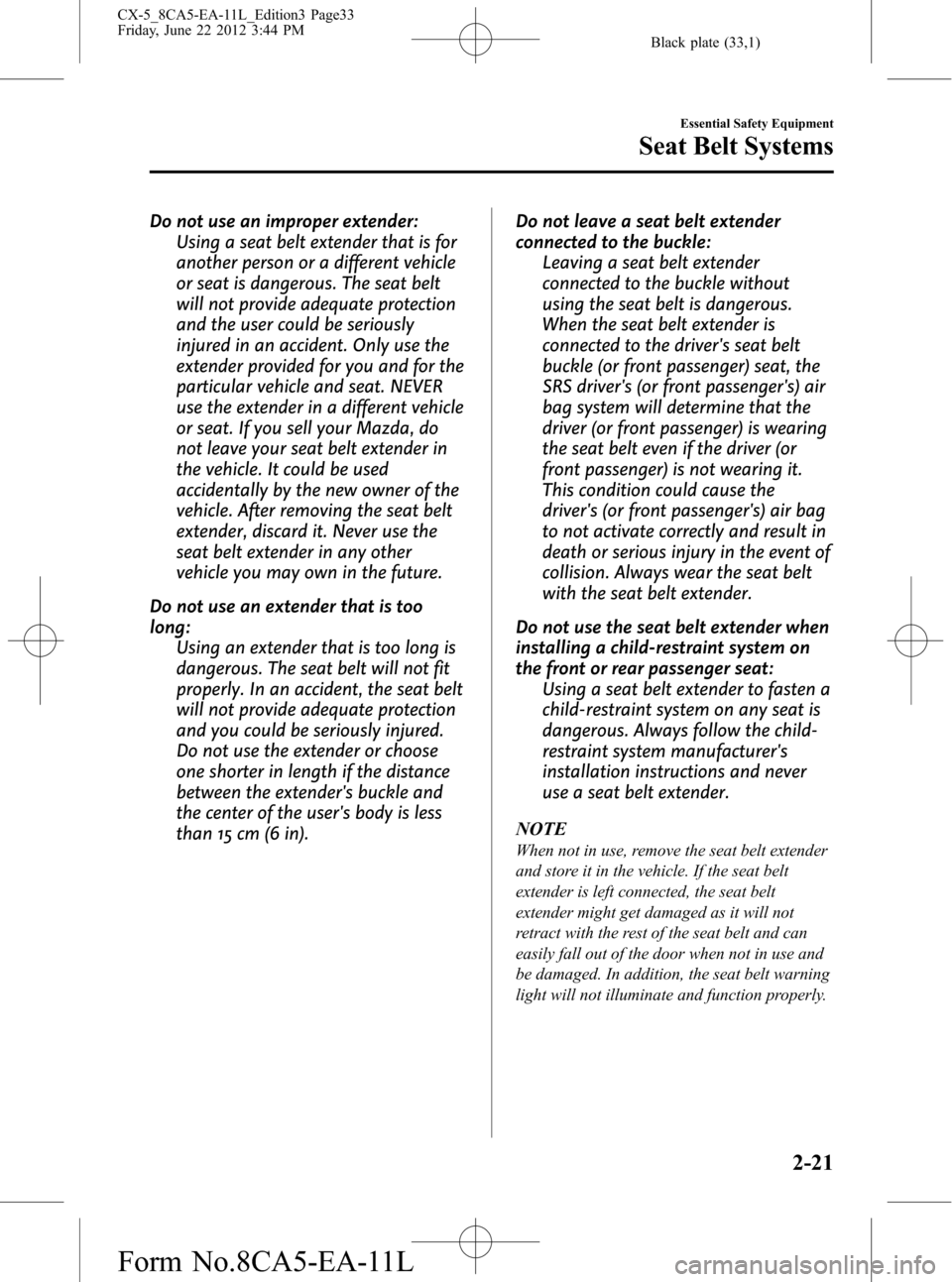
Black plate (33,1)
Do not use an improper extender:
Using a seat belt extender that is for
another person or a different vehicle
or seat is dangerous. The seat belt
will not provide adequate protection
and the user could be seriously
injured in an accident. Only use the
extender provided for you and for the
particular vehicle and seat. NEVER
use the extender in a different vehicle
or seat. If you sell your Mazda, do
not leave your seat belt extender in
the vehicle. It could be used
accidentally by the new owner of the
vehicle. After removing the seat belt
extender, discard it. Never use the
seat belt extender in any other
vehicle you may own in the future.
Do not use an extender that is too
long:
Using an extender that is too long is
dangerous. The seat belt will not fit
properly. In an accident, the seat belt
will not provide adequate protection
and you could be seriously injured.
Do not use the extender or choose
one shorter in length if the distance
between the extender's buckle and
the center of the user's body is less
than 15 cm (6 in).Do not leave a seat belt extender
connected to the buckle:
Leaving a seat belt extender
connected to the buckle without
using the seat belt is dangerous.
When the seat belt extender is
connected to the driver's seat belt
buckle (or front passenger) seat, the
SRS driver's (or front passenger's) air
bag system will determine that the
driver (or front passenger) is wearing
the seat belt even if the driver (or
front passenger) is not wearing it.
This condition could cause the
driver's (or front passenger's) air bag
to not activate correctly and result in
death or serious injury in the event of
collision. Always wear the seat belt
with the seat belt extender.
Do not use the seat belt extender when
installing a child-restraint system on
the front or rear passenger seat:
Using a seat belt extender to fasten a
child-restraint system on any seat is
dangerous. Always follow the child-
restraint system manufacturer's
installation instructions and never
use a seat belt extender.
NOTE
When not in use, remove the seat belt extender
and store it in the vehicle. If the seat belt
extender is left connected, the seat belt
extender might get damaged as it will not
retract with the rest of the seat belt and can
easily fall out of the door when not in use and
be damaged. In addition, the seat belt warning
light will not illuminate and function properly.
Essential Safety Equipment
Seat Belt Systems
2-21
CX-5_8CA5-EA-11L_Edition3 Page33
Friday, June 22 2012 3:44 PM
Form No.8CA5-EA-11L
Page 34 of 488
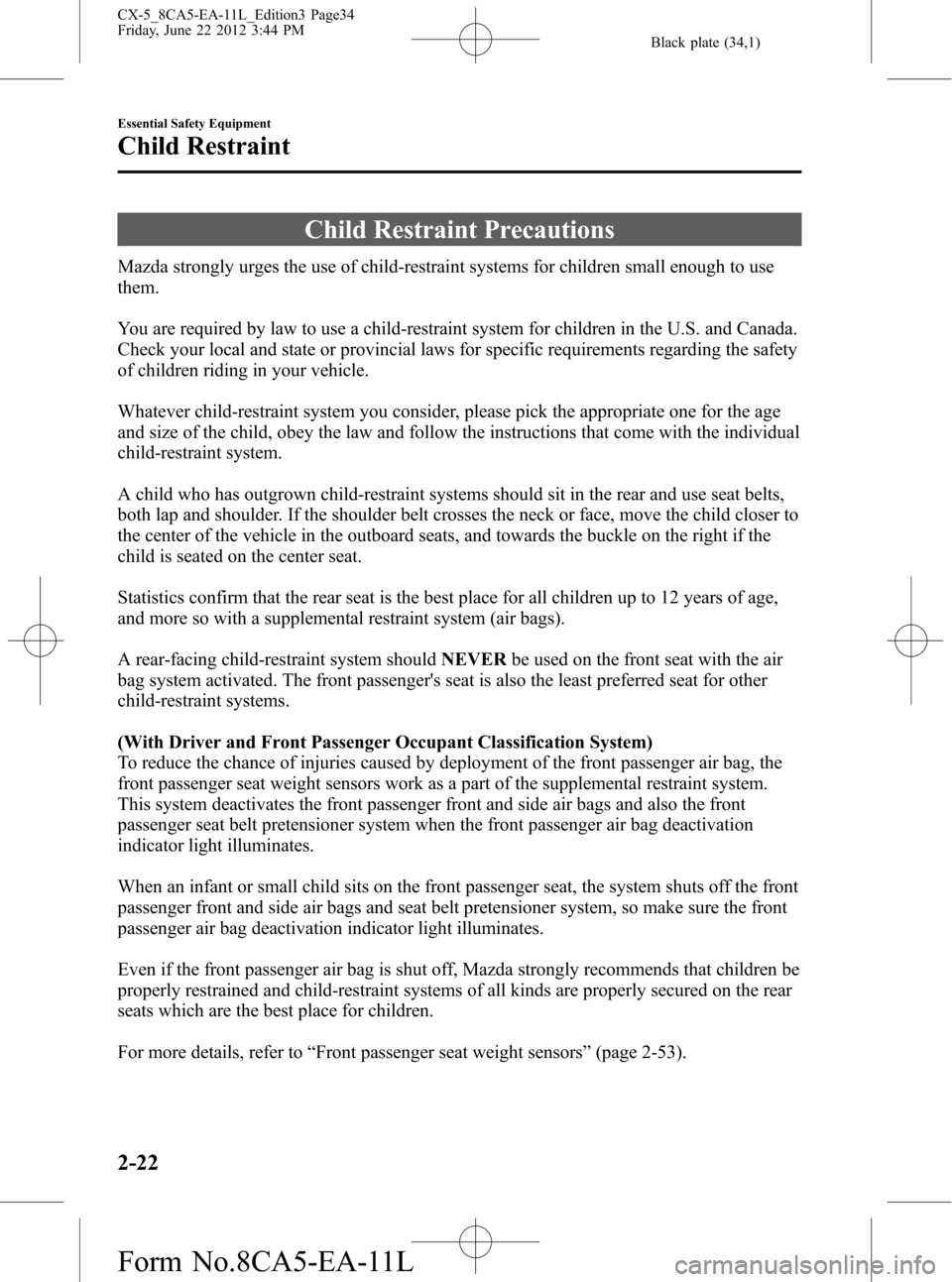
Black plate (34,1)
Child Restraint Precautions
Mazda strongly urges the use of child-restraint systems for children small enough to use
them.
You are required by law to use a child-restraint system for children in the U.S. and Canada.
Check your local and state or provincial laws for specific requirements regarding the safety
of children riding in your vehicle.
Whatever child-restraint system you consider, please pick the appropriate one for the age
and size of the child, obey the law and follow the instructions that come with the individual
child-restraint system.
A child who has outgrown child-restraint systems should sit in the rear and use seat belts,
both lap and shoulder. If the shoulder belt crosses the neck or face, move the child closer to
the center of the vehicle in the outboard seats, and towards the buckle on the right if the
child is seated on the center seat.
Statistics confirm that the rear seat is the best place for all children up to 12 years of age,
and more so with a supplemental restraint system (air bags).
A rear-facing child-restraint system shouldNEVERbe used on the front seat with the air
bag system activated. The front passenger's seat is also the least preferred seat for other
child-restraint systems.
(With Driver and Front Passenger Occupant Classification System)
To reduce the chance of injuries caused by deployment of the front passenger air bag, the
front passenger seat weight sensors work as a part of the supplemental restraint system.
This system deactivates the front passenger front and side air bags and also the front
passenger seat belt pretensioner system when the front passenger air bag deactivation
indicator light illuminates.
When an infant or small child sits on the front passenger seat, the system shuts off the front
passenger front and side air bags and seat belt pretensioner system, so make sure the front
passenger air bag deactivation indicator light illuminates.
Even if the front passenger air bag is shut off, Mazda strongly recommends that children be
properly restrained and child-restraint systems of all kinds are properly secured on the rear
seats which are the best place for children.
For more details, refer to“Front passenger seat weight sensors”(page 2-53).
2-22
Essential Safety Equipment
Child Restraint
CX-5_8CA5-EA-11L_Edition3 Page34
Friday, June 22 2012 3:44 PM
Form No.8CA5-EA-11L
Page 35 of 488

Black plate (35,1)
WARNING
Use the correct size child-restraint system:
For effective protection in vehicle accidents and sudden stops, a child must be
properly restrained using a seat belt or child-restraint system depending on age and
size. If not, the child could be seriously injured or even killed in an accident.
Follow the manufacturer's instructions and always keep the child-restraint system
buckled down:
An unsecured child-restraint system is dangerous. In a sudden stop or a collision it
could move causing serious injury or death to the child or other occupants. Make
sure any child-restraint system is properly secured in place according to the child-
restraint system manufacturer's instructions. When not in use, remove it from the
vehicle or fasten it with a seat belt, or latch it down to BOTH LATCH lower anchors
for LATCH child-restraint systems and the corresponding tether anchor.
Always secure a child in a proper child-restraint system:
Holding a child in your arms while the vehicle is moving is extremely dangerous. No
matter how strong the person may be, he or she cannot hold onto a child in a
sudden stop or collision and it could result in serious injury or death to the child or
other occupants. Even in a moderate accident, the child may be exposed to air bag
forces that could result in serious injury or death to the child, or the child may be
slammed into an adult, causing injury to both child and adult.
Never use a rear-facing child-restraint system in the front seat with an air bag that
could deploy:
Rear-facing child-restraint systems on the front seat are particularly dangerous even
though you may feel assured that a front passenger air bag will not deploy based on
the fact that the front passenger air bag deactivation indicator light illuminates. The
child-restraint system can be hit by a deploying air bag and moved violently
backward resulting in serious injury or death to the child.
Essential Safety Equipment
Child Restraint
2-23
CX-5_8CA5-EA-11L_Edition3 Page35
Friday, June 22 2012 3:44 PM
Form No.8CA5-EA-11L
Page 36 of 488
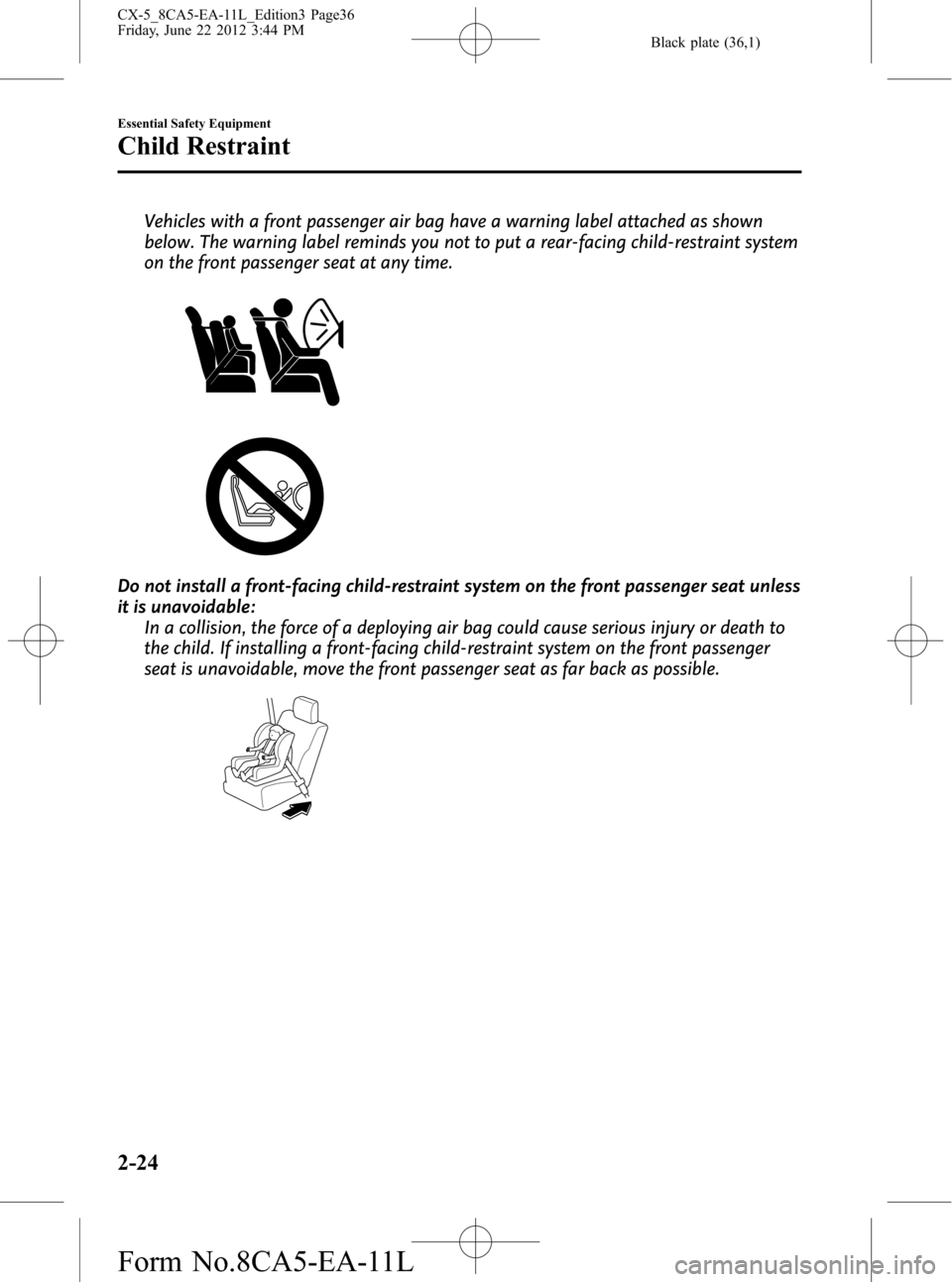
Black plate (36,1)
Vehicles with a front passenger air bag have a warning label attached as shown
below. The warning label reminds you not to put a rear-facing child-restraint system
on the front passenger seat at any time.
Do not install a front-facing child-restraint system on the front passenger seat unless
it is unavoidable:
In a collision, the force of a deploying air bag could cause serious injury or death to
the child. If installing a front-facing child-restraint system on the front passenger
seat is unavoidable, move the front passenger seat as far back as possible.
2-24
Essential Safety Equipment
Child Restraint
CX-5_8CA5-EA-11L_Edition3 Page36
Friday, June 22 2012 3:44 PM
Form No.8CA5-EA-11L